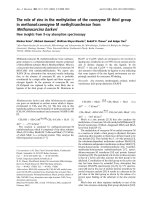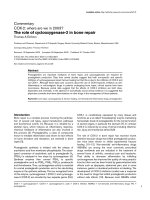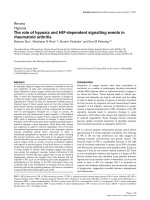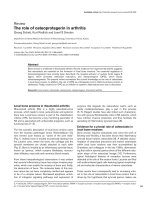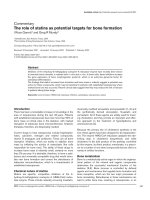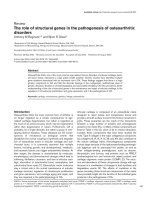Báo cáo y học: " The role of teams in resolving moral distress in intensive care unit decision-making" doc
Bạn đang xem bản rút gọn của tài liệu. Xem và tải ngay bản đầy đủ của tài liệu tại đây (31.73 KB, 2 trang )
217
ICU = intensive care unit.
Available online />Case
Sara, a 23-year-old woman, was admitted to the transplant
service with early-onset idiopathic pulmonary fibrosis,
neutropenia and anemia. Both her mother and brother were
affected with the same disorder. Her mother died several
years ago, ventilated in the intensive care unit (ICU); a death
Sara describes as horrible. After witnessing the death of her
mother, Sara said repeatedly “I will never die that way”. As a
result she appointed her aunt power of attorney for personal
care. Her brother had a successful transplant 3 years ago
and is known to the transplant team.
Sara has now deteriorated with possible community-acquired
pneumonia (cultures negative to date) and is hypotensive. In
discussion with the transplant team Sara says she wants a
transplant, but refuses ventilation. Her last words to the ICU
team before intubation are: “No don’t put the tube down … I
don’t want it … I don’t want to die like my mother … please,
no”. On the night that Sara’s condition deteriorated, the
decision to intubate was made by the ICU resident with
support from the transplant team.
After 10 days, the patient remains unstable on increasing
ventilatory support. The family is insistent on continuing
treatment despite the earlier wishes of Sara. The transplant
team assures the family that Sara can be maintained
indefinitely on ventilation and they can perform the transplant
unless she gets an infection. The ICU team is experiencing
growing tension, as their efforts to maintain life support are
increasingly difficult with little hope of survival. Sara is now
on high-frequency oscillating ventilation. The ICU nurses are
unclear of the plan as previously policy stipulated that
ventilated patients were not transplant candidates. They find
the family’s expectations of complete recovery unrealistic.
They want to know what is realistic to expect.
Introduction
We are faced in critical care with the need to make decisions
when every second counts. In the moment, inaction results in
death so we err on the side of life. Patients’ wishes about
degrees of intervention may be clear but are often
disregarded by physicians given the uncertainty of predicting
critical care outcomes [1]. The aftermath of such immediate
Commentary
The role of teams in resolving moral distress in intensive care
unit decision-making
Mary van Soeren
1
and Adèle Miles
2
1
Assistant Professor, School of Nursing, Atkinson Faculty of Liberal and Professional Studies, York University, Toronto, Canada
2
Pastoral Care Consultant, St Thomas-Elgin General Hospital, St Thomas, Canada
Correspondence: Mary van Soeren,
Published online: 7 March 2003 Critical Care 2003, 7:217-218 (DOI 10.1186/cc2168)
This article is online at />© 2003 BioMed Central Ltd (Print ISSN 1364-8535; Online ISSN 1466-609X)
Abstract
Conflicts arise within teams and with family members in end-of-life decision-making in critical care. This
creates unnecessary discomfort for all involved, including the patient. Treatment plans driven by crisis
open the team up to conflict, fragmented care and a lack of focus on the patient’s wishes and realistic
medical outcomes. Methods to resolve these issues involve planned ethical reviews and team meetings
where open communication, clear plans and involvement in decision-making for all stakeholders occur.
In spite of available literature supporting the value of these techniques, patient care teams and families
continue to find themselves involved in spiraling conflict, pitting one team against another, placing blame
on family members for not accepting decisions made by the team and creating moral conflict for
interdisciplinary team members. Through a case presentation, we review processes available to help
resolve conflict and to improve outcome.
Keywords critical care, moral distress, physician–nurse relationship, team interaction
218
Critical Care June 2003 Vol 7 No 3 van Soeren and Miles
actions can lead patients, families and care providers into a
grey area of supporting life where there is increasingly little
hope of recovery. The result is a shift towards prolonging
death. This situation is found in critical care units around the
world. The present case illustrates a situation where treating
teams and the family are at odds. Their respective
expectations and plans create a situation of moral distress. In
the present article, we shall explore how team interaction and
communication could be used to improve the outcome for all
involved.
Issues
Nurses ask “what are we doing?”, “is there any hope?” and
“the family thinks she will go home, and is that realistic?”.
They ask questions about the appropriateness of treatment
plans and sometimes feel they are unable to act in the best
interest of the patient and family [2]. The issue of futility is
complex, and interpretation may involve varying perspectives
of ethical principles and values. Some argue that futility can
only be determined from a patient-focused perspective after
considering what the treatment represents to the patient
regardless of medical indication [3].
Results from studies indicate some physicians have difficulty
in accepting that not all treatment can or should be instituted.
And not all physicians involved in a particular case agree with
an aggressive treatment plan [4]. The concept of withdrawing
life support after it has been started is difficult for families
and some care providers to accept. Disagreements in life
support treatment plans can result in moral distress among
care providers. This can have a detrimental impact on the
family, especially if their opinions regarding life support are
different from the treating team. The cycle of blame and
unyielding applications of salvage treatments take the place
of open communication and clear plans.
Another approach
In the moment, decisions need to be made quickly. Later,
between crises, review of the overall treatment plan is both
possible and desirable. Creating a process for regular
interdisciplinary team reviews of the patient’s progress with
input from all those involved in the care, including the family,
serves several purposes. First, the team has an opportunity to
take a step back and see the big picture. Hearing from each
member of the team helps to give a broader framework for
decision-making. Instead of dealing with a series of crises,
the team is able to look at overall continuity and expectations.
Members of the team who are unclear about a realistic
prognosis can ask questions to gain understanding. Some
teams may be reluctant to join such meetings at first.
However, making them mandatory for all long-term cases
would have a positive impact on patient care and on team
cohesiveness.
The family benefits by feeling that their perspective is heard
and valued. Furthermore, they benefit from hearing the full
story. Too often, in dealing with one problem at a time,
families and other team members lose track of the patient.
A further benefit is the development of trust among team
members. The sharing of perspectives can garner support for
those unable to stop treatment and for those uncomfortable
with the level of uncertainty in the prognosis. This open
dialogue provides a vehicle for resolution of polarity in
differing perspectives.
Another resource available to teams is an ethics review. In
qualitative studies, resolution of lack of consensus was
facilitated through use of this process with consistent
decreases in medical interventions [5]. Furthermore, a
proactive approach resolves conflicts earlier with less harm
to all involved.
Conclusion
The necessity of immediate decisions in critical care often
results in cases where, upon reflection, different decisions
might be made. Mechanisms through which teams can
discuss differences and create clarity around treatment
rationales will therefore improve team function. The
development of interdisciplinary trust and a cohesive plan of
care create a more stable and consistent environment for the
family and for the patient. Ethical reviews support the team in
situations of conflict, and in decisions where appropriate
withholding or withdrawing of treatment is necessary.
Following 14 days of ICU care, Sara received a transplant.
She died 10 days later following a cardiac arrest on
extracorporeal membrane oxygenation and continuous veno-
venous hemodialysis without receiving any palliative care.
Competing interests
None declared.
References
1. Asch DA, Hansen-Flaschen J, Lanken PN: Decisions to limit or
continue life-sustaining treatment by critical care physicians
in the United States: conflicts between physicians’ practices
and patients’ wishes. Am J Respir Crit Care Med 1995, 151:
288-292.
2. Canadian Nurses Association: Futility presents many chal-
lenges for nurses. Can Nurse 2001, 97:5-8.
3. Taylor C: Medical futility and nursing. Image J Nursing Scholar-
ship 1995, 27:301-306.
4. Solomon MZ, O’Donnell L, Jennings B, Guilfoy V, Wolf SM, Nolan
K, Jackson R, Koch-Weser D, Donnelley S: Decisions near the
end of life: professional views on life-sustaining treatments.
Am J Public Health 1993, 83:14-23.
5. DuVal G, Sartorius L, Clarridge B, Gensler G, Danis M: What trig-
gers requests for ethics consultations? J Med Ethics 2001, 27
(suppl 1):i24-i29.


